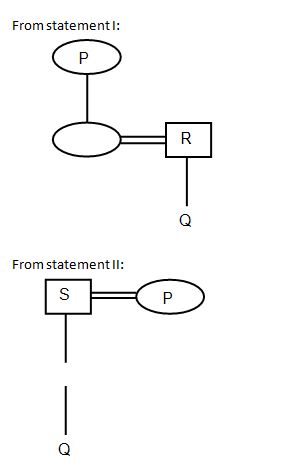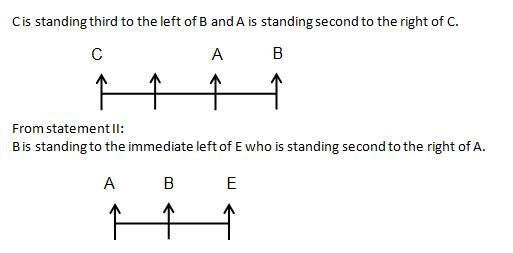Welcome to Online Quantitative Aptitude section in AffairsCloud.com. Here we are creating question sample From DATA SUFFICIENCY which is BASED ON Bank EXAMS !!!
Data Sufficiency
(Directions 1 – 10): Study the following information and answer the questions given below:
- Marks of five students A, B, C, D and E are compared. Who among the following got the highest marks?
I. A got highest marks than D and B but not than E.
II. C did not get the highest marks.
III. D did not get the lowest marks.
1) Only I and either II or III
2) Question cannot be answered even with all the statements together
3) Only statement I
4) Only statement III
5) Both statement I and IIAnswer – 5) Both statement I and II
Explanation :
From statement I:
A > D, A > B, E > A
From statement II:
C did not get the highest marks.
From statement III:
D did not get the lowest marks.
Both statements I and II together:
E > A > D, B and C did not get the highest marks.
Hence, E got the highest marks. - How is P related to Q?
I. P is the mother-in-law of R who is the father of Q.
II. S is the grandfather of Q and also the husband of P.
1) If the data in statement I alone are sufficient to answer the question, while the data in statement II alone are not sufficient to answer the question.
2) If the data in statement II alone are sufficient to answer the question, while the data in statement I alone are not sufficient to answer the question.
3) If the data either in statement I alone or in statement II alone are sufficient to answer the question.
4) If the data even in both statements I and II together are not sufficient to answer the question.
5) If the data in both statement I and II together are necessary to answer the question.Answer – 3) If the data either in statement I alone or in statement II alone are sufficient to answer the question.
Explanation :

- On which day of the week the exam is scheduled?
I. Exam is not on weekend (i.e., Saturday and Sunday)
II. Monday is dedicated to outdoor activities and Friday is dedicated to cultural events.
III. Exam is not immediately after outdoor activities and not immediately before the cultural events.
1) All the statements are required to answer the question.
2) Only statement I is sufficient.
3) Only statement II is sufficient.
4) Only statement III is sufficient.
5) Question cannot be answered with all the statements togetherAnswer – 1) All the statements are required to answer the question.
Explanation :
From statement I:
Exam is not on Saturday or Sunday
Exam could be on Monday, Tuesday, Wednesday, Thursday or Friday.From statement II:
Exam is not on Monday (outdoor activities) or Friday (cultural events).
Exam could be on Sunday, Tuesday, Wednesday, Thursday or Saturday.From statement III:
Exam is not immediately after outdoor activities or immediately before cultural events.
Exam could be on Sunday, Monday, Tuesday, Wednesday, Thursday, Friday or Saturday. It depends upon the days which are dedicated to outdoor activities and Cultural events.By combining all the statements together:
Exam is scheduled on Wednesday. - There are three friends A, B and C. What is the difference between the ages of A and B?
I. A is the eldest person among all the 3 friends.
II. The age difference between the eldest and youngest persons is 10 years.
III. C’s age is 20
1) All the three statements are required to answer the question.
2) Only statements I and II are sufficient.
3) Only statements I and III are sufficient.
4) Only statements II and III are sufficient.
5) Question cannot be answered with all the statements together.Answer – 5) Question cannot be answered with all the statements together.
Explanation :
Given that:
From statement I:
A is the eldest person.From statement II:
The age difference between the eldest and youngest persons is 10 years.From statement III:
C’s age is 20.Hence, this question cannot be answered with all the statements together.
- What is the rank of P from the bottom in a class of 20 students?
I. Q is third from the top and there are five students between Q and P.
II. The rank of R is fourth from the bottom and there are 7 students between R and P.
1) The data either in statement I alone or in statement II or in statement III alone are sufficient to answer the question.
2) The data in both statements I and II together are necessary to answer the question.
3) The data in statement I alone are sufficient to answer the question, while the data in statement II alone are not sufficient to answer the question.
4) The data in statement II alone are sufficient to answer the question, while the data in statement I alone are not sufficient to answer the question.
5) The data even in both statements I and II together are not sufficient to answer the question.Answer – 1) The data either in statement I alone or in statement II or in statement III alone are sufficient to answer the question.
Explanation :
From statement I:
Q is third from the top and there are five students between Q and P.
As P is at 9th position from top.
There are total 20 students. So, rank of P from bottom is 12th.
So, statement I alone is sufficient to answer this question.From statement II:
The rank of R is fourth from the bottom and there are 7 students between R and P.
Rank of P from bottom will be 4 + 7 + 1 = 12th
So, statement II alone is sufficient to answer this question. - What is the code for ‘smart’ in the code language?
I. In the code language, ‘Ram is smart’ is written as ‘Ab Bc De’
II. In the same language, ‘Smart people are intelligent’ is written as ‘Bc Cd Ef Gh’
III. In the same language, ‘Riya is intelligent’ is written as ‘Ab Cd Fg’
1) All the statements are needed to answer the question.
2) Only statements I and III are sufficient.
3) Only statements I and II are sufficient.
4) Only statements II and III are sufficient.
5) Question cannot be answered even with the information in all the statements.Answer – 3) Only statements I and II are sufficient.
Explanation :
The word ‘smart’ is common only in the statements I and II and the common code is ‘Bc’. Hence, only statement I and II are sufficient. - What is the position of P with respect to S?
I. Q is left to R.
II. S is south to R and south-west to T.
III. Q is south to P.
1) All the statements are required to answer the question.
2) Only statements I and II are sufficient.
3) Only statements II and III are sufficient.
4) Only statements I and III are sufficient.
5) Question cannot be answered even with the information in all three statements.Answer – 1) All the statements are required to answer the question.
Explanation :

- Five buildings A, B, C, D and E are standing in a straight line facing north. Which is standing to the immediate right of A?
I. C is standing third to the left of B and A is standing second to the right of C.
II. B is standing to the immediate left of E who is standing second to the right of A.
1) The data in statement II alone are sufficient to answer the question, while the data in statement I alone are not sufficient to answer the question
2) The data even in both statements I and II together are not sufficient to answer the question
3) The data either in statement I alone or in statement II alone are sufficient to answer the question
4) The data in statement I alone are sufficient to answer the question, while the data in statement II alone are not sufficient to answer the question
5) The data in both statements I and II together are necessary to answer the questionAnswer – 3) The data either in statement I alone or in statement II alone are sufficient to answer the question
Explanation :

- Among birds P, Q, R, S, T and U which has the most sweet voice?
I. R has more sweet voice than only two birds. Q has more sweet voice than P but not the sweetest. T has more sweet voice than only U.
II. P has less sweet voice than only two birds. T has more sweet voice than U but less sweet voice than R. R has less sweet voice than P. Q has less sweet voice than S.
1) The data in statement II alone are sufficient to answer the question, while the data in statement I alone are not sufficient to answer the question
2) The data even in both statements I and II together are not sufficient to answer the question
3) The data either in statement I alone or in statement II alone are sufficient to answer the question
4) The data in statement I alone are sufficient to answer the question, while the data in statement II alone are not sufficient to answer the question
5) The data in both statements I and II together are necessary to answer the questionAnswer – 3) The data either in statement I alone or in statement II alone are sufficient to answer the question
Explanation :
From statement I:
R has more sweet voice than only two birds. Q > P but Q has not the sweetest voice. T has more sweet voice than only U.
S > Q > P > R > T > U
From statement II:
P has less sweet voice than only two birds. T > U, R > T. P > R. S > Q
S > Q > P > R > T > U - Among six girls – P, Q, R, S, T and U each having a different height who is the second tallest?
I. Only two people are shorter than S. Only two people are taller than P. T is shorter than R. Q is taller than only U.
II. Only three people are shorter than P. Q is shorter than S but not the shortest. R is the tallest amongst them.
1) The data in statement II alone are sufficient to answer the question, while the data in statement I alone are not sufficient to answer the question
2) The data even in both statements I and II together are not sufficient to answer the question
3) The data either in statement I alone or in statement II alone are sufficient to answer the question
4) The data in statement I alone are sufficient to answer the question, while the data in statement II alone are not sufficient to answer the question
5) The data in both statements I and II together are necessary to answer the questionAnswer – 4) The data in statement I alone are sufficient to answer the question, while the data in statement II alone are not sufficient to answer the question
Explanation :
From statement I:
Only two people are shorter than S. Only two people are taller than P. R > T. Q > U.
R > T > P > S > Q > UFrom statement II:
Only three people are shorter than P. S > Q and Q is not the shortest. R is not the tallest.Hence, statement I alone is sufficient to answer this question.
AffairsCloud Recommends Oliveboard Mock Test
AffairsCloud Ebook - Support Us to Grow
Govt Jobs by Category
Bank Jobs Notification





